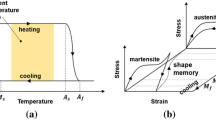Abstract
The key points to consider in determining the effectiveness of using structural isolation with shape memory alloys (SMA) are the constitutive model, the SMA isolation device and the analysis method. In this paper, a simplified constitutive model based on the classic theory of plasticity is proposed to simulate the behavior of the superelasticity of the SMA, in which the martensite volume fraction is considered as one of the state variables. Comparisons between simulation results and experimental results are made and indicate that the proposed constitutive model yields stress-strain curves that are in good agreement with the experimental ones. Thus, the proposed model can correctly simulate the yield mechanism and energy dissipation capacity of the SMA. Next, in order to make full use of the superelasticity of SMA, a new SMA isolator composed of pre-tensioned SMA bars is presented. Then, a finite element analytical model is established to simulate the behavior of the SMA isolator according to its configuration and simplified constitutive model. Finally, a simplified design method for long-span structures installed with SMA isolators is proposed, which is further used to investigate the isolation effects of a space grid structure. Results show that the SMA isolator can reduce the seismic responses of the structure effectively, which indicates the effectiveness of the proposed SMA isolation method.
Similar content being viewed by others
Reference
Casciati F and Hamdaoui K (2008), “Modelling the Uncertainty in the Response of a Base Isolator,” Probabilistic Engineering Mechanics, 23(4): 427–437.
Casciati F, Faravelli L and Al Saleh R (2009), “An SMA Passive Device Proposed Within the Highway Bridge Benchmark,” Structural Control and Health Monitoring, 16(6): 657–667.
Chen HQ, Li ZX and Liu DM (2006), “Bridge Isolation Based on SMA-Composite Rubber Bearing,” Journal of Tianjin University, 39(S1): 198–202. (in Chinese)
Dolce M, Cardone D and Marnetto R (2000), “Implementation and Testing of Passive Control Devices Based on Shape Memory Alloys”, Earthquake Engineering and Structural Dynamics, 29(2): 945–968.
Dolce M, Cardone D and Ponzo FC (2007), “Shakingtable Tests on Reinforced Concrete Frames with Different Isolation Systems,” Earthquake Engineering and Structural Dynamics, 36(5): 573–596.
Jia GF and Shi ZF (2010), “A New Seismic Isolation System and Its Feasibility Study,” Earthquake Engineering and Engineering Vibration, 9(1): 75–82.
Malécot P, Lexcellent C, Foltête E, et al. (2006), “Shape Memory Alloys Cyclic Behavior: Experimental Study and Modeling”, Journal of Engineering Materials and Technology, 128(3): 335–345.
Panayiotis CR, Panos CT and Michael CC (2010), “Nonliear Dynamic Analysis of Multi-base Seismically Isolated Structures with Uplift Potential II: Verification Examples,” Earthquake Engineering and Engineering Vibration, 9(1): 83–92.
Ren WJ, Li HN and Song GB (2008), “Frequency Dependent Constitutive Model for Superelastic Shape Memory Alloy for Application in Engineering”, Engineering Mechanics, 25(9): 52–59. (in Chinese)
Shook DA, Roschke PN and Ozbulut OE (2008), “Superelastic Semi-active Damping of a Base-isolated Structure,” Structural Control and Health Monitoring, 15(5): 746–768.
Wu DM, Liu ST and Liu ZY (2007), “Seismic Response Analysis of Torch Tower with SMA-rolling Bearings,” Journal of Guangzhou University (Natural Science Edition), 6(1): 82–86. (in Chinese)
Zhuang P, Xue SD and Li BS (2006a), “Dynamic Responses of a Seismic Isolation System Using SMArubber Bearing,” Journal of Vibration and Shock, 25(3): 85–89. (in Chinese)
Zhuang P, Xue SD and Li BS (2006b), “Theoretical Model for Hysteretic Behavior of SMA-rubber Bearings,” Journal of Beijing University of Technology, 32(10): 890–894. (in Chinese)
Zuo XB, Li AQ and Chen QF (2008), “Design and Analysis of a Superelastic SMA Damper,” Journal of Intelligent Material Systems and Structures, 19(6): 631–639.
Zuo XB, Li AQ, Ni LF, et al. (2004), “Experimental Investigations of Mechanical Behavior of Superelastic NiTi Shape Memory Alloy (SMA) Wires,” Proceedings of the Third International Conference on Earthquake Engineering, Nanjing, China, pp. 878–882.
Zuo XB, Li AQ, Sun W, et al. (2009), “Optimal Design of Shape Memory Alloy Damper for Cable Vibration Control,” Journal of Vibration and Control, 15(6): 897–921.
Author information
Authors and Affiliations
Corresponding author
Additional information
Supported by: National Natural Science Foundation of China Under Grant No. 50725828 & No. 50808041; Scientific Research Foundation of Graduate School of Southeast University Under Grant No. YBJJ1006; Teaching and Research Foundation for Excellent Young Teacher of Southeast University.
Rights and permissions
About this article
Cite this article
Ding, Y., Chen, X., Li, A. et al. A new isolation device using shape memory alloy and its application for long-span structures. Earthq. Eng. Eng. Vib. 10, 239–252 (2011). https://doi.org/10.1007/s11803-011-0062-4
Received:
Accepted:
Published:
Issue Date:
DOI: https://doi.org/10.1007/s11803-011-0062-4




